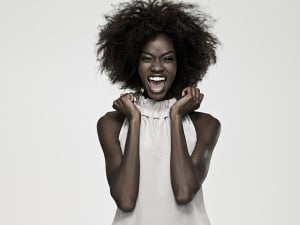As an avid reader of women’s sites, I see a new headline literally every day that starts with “These Side-By-Side Photos” or “This Body-Positive Blogger” and has an Instagram post embedded. Heck, I’ve even written a couple of them.
But I also kind of cringe at them.
If it seems to you like all these viral Instagrams look the same, it’s not your imagination. They’re incredibly homogenous.
And if any of them leave you feeling less good about your body, that’s also not just you. Some of them aren’t even all that body-positive, and a lot contain mixed messages.
While I support these people and their efforts to promote body positivity, there’s a lot of room for improvement.
Here are some issues I’ve noticed with body-positive Instagrams – and how we can all do better.
1. Thin, White, Conventionally Attractive Women Are Getting the Most Attention
It’s pretty ironic that the faces of a movement based on accepting those who don’t meet society’s beauty standards are people who – well – meet society’s beauty standards.
That’s not to say others aren’t out there. Many fat people, people of color, and genderqueer people are working tirelessly to fight diet culture and inspire people to accept themselves. If you don’t know who I’m referring to, try checking out @tessholliday, @mynameisjessamyn, @gabifresh, @ihartericka, @isupersheng, and @itsmekellieb.
But scroll to the health pages of popular women’s sites, and it’s not so often you’ll see people like them.
Instead, you’ll find Instagrammers who are white, conventionally attractive, and thin or average size.
I don’t mean to imply that these people don’t have body image struggles or that they don’t deserve to love their bodies. Body positivity is for everyone, including thin and conventionally attractive people.
But the people who are hurt the most by body negativity – and therefore need body positivity the most – are weirdly invisible. And these people often offer a more radical version of body positivity, which could help us all.
Privileged people on body positive Instagrams have inspired a lot of people, and that’s great. I don’t want them to stop. I’d just like to be seeing a greater variety of people highlighted along with them.
To solve this problem, people on Instagram can make an effort to seek out (and re-gram) marginalized folks like the ones on this list and this list, and publications can also include them in their articles rather than drawing from the same accounts every time.
2. There Are Still Some Body-Negative Messages in There
A lot of body positivity online and offline sounds like “love yourself even if you haven’t met your fitness and beauty goals, but still strive toward those goals.”
Or worse, “Alter your body so that you’ll love it. Do it for yourself!”
But can you really accept your size but want to change it? I don’t think so. The very definition of accepting something is not wanting to change it.
So, it’s frustrating to see people talking about how your body’s not a problem and then telling you how to fix it.
Fitness blogger Anna Victoria, for example, recently posted a photo with her cellulite showing to normalize cellulite. “Stop thinking you’re the only one with cellulite and that it’s some kind of disease!” she wrote, which is so true: 90% of people who produce a lot of estrogen get it.
But she follows this up with:
“It’s not bad to want to reduce the sight of cellulite, just like it’s not bad to want to lose weight and feel more confident overall, but don’t set out to lose weight just to have less cellulite. It can be a cherry on top of all the other amazing benefits. If you ask me how to reduce the appearance of cellulite, my answer will be: healthy diet, regular exercise, and proper water intake – that’s it.”
So, in other words, it’s okay to have cellulite, but if you can get rid of it, great, and here’s how. The second part totally detracts from the first.
Many body-positive Instagrams are also punctuated with pictures of “healthy” low-calorie, low-fat, or low-carb meals or pictures documenting the Instagrammers’ progress in attaining the appearance they want.
Instagrams like these feed into a major myth diet culture teaches us: that you can love your body and change it – or even love it by changing it.
This can be especially harmful to people in eating disorder recovery who are trying so hard to avoid compromising with their eating disorders and reject all body-negative ideas.
If we really want to promote body positivity, we need to promote it without qualifiers or contradictions.
We need to declare that skin with cellulite is perfect, not suboptimal, but acceptable.
We need to proclaim that fat is beautiful, not just tolerable. Instead of documenting our habits as if we’ll love our bodies more once we lose weight, we need to acknowledge that all the self-love we can feel is available to us right now.
3. Those Photo Comparisons Have Some Negative Implications
Some of the most popular body-positive Instagram posts I see are those with two photos side by side to show how lighting, pose, and camera angle can affect how someone looks.
In general, I like these because they remind me not to freak out about “bad” photos of myself.
But we also need to challenge the very concept of a “good” or “bad” photo – and that’s where I often see these fall short.
The implication of these posts is usually that even thin, attractive people can have stomach rolls or bloating, so you shouldn’t worry if you do.
By reassuring people that they’re not fat, these photos depict fat as bad, which is inherently anti-fat.
What about people with stomach rolls that don’t go away when they stand up straight or stomachs that stick out long after they’ve eaten?
These people deserve to feel good about their bodies unconditionally, not to reassure themselves that they’re just having a bad day or that a photo they’ve seen of themselves isn’t what they really look like.
4. Using Thin Bodies to Represent Unconventional Beauty
An Instagram post that went viral this summer shows a picture of Amy Schumer next to a statue of Aphrodite.
“So many women and young girls are shamed by the media and fashion industry for not having a flat stomach and not being a size zero,” the post’s author @whitneyzombie wrote.
“But look, the goddess of beauty is portrayed here with stomach rolls and doesn’t have a perfectly smooth, toned body. I want to remind everyone that they do not have to be a Victoria’s Secret model to be a beautiful goddess with a beautiful body.”
This is a sweet message and a useful reminder that you don’t have to be thin to be considered attractive. However, Amy Schumer is thin. (She says she’s between a size six and eight, and the national average is sixteen.) And so is that Aphrodite statue.
Having stomach rolls isn’t radical. Thin people have them. By portraying them as out of the ordinary and revolutionary, we’re actually contributing to the stigma against them.
Considering a Greek goddess beautiful isn’t radical either.
Aphrodite may have a little bit more fat than society’s current ideal, but she has less fat than your average person, and she has very idealized proportions. Greek statues also represent a white, Eurocentric ideal of beauty.
Instagrams like these reflect a bigger problem throughout the media: People with really conventionally attractive bodies, like Kim Kardashian and Beyoncé, are portrayed as larger than normal, which perpetuates a really messed up idea of what normal is.
By using these bodies to represent people who are larger, we’re making average sized and thin people feel large and large people feel invisible.
Since fat people are the group that suffers the most from fat oppression, they should have the biggest role in the body positivity movement.
Instead of sharing pictures showing how thin or average-sized people are beautiful, which just reiterates the dominant narrative, we should be reminding everyone that fat is beautiful.
***
I appreciate the vulnerability it takes to pose in your underwear or write about your body image struggles, so this is not a condemnation of body-positive Instagrammers. They have helped a lot of people.
And the last thing I would want to do is put even more pressure on women to censor themselves. It’s better to speak up and risk making mistakes than to say silent because you’re afraid of offending someone.
But then, when we make those mistakes (which we will), we have to own them and try to do better.
Body positivity has the potential to be really radical.
But right now, the image many people have of it consists of hot, skinny women posing in bad lighting to show barely existent cellulite and giving advice on getting rid of it.
Again, I don’t want to trivialize the courage that may take. To the body positive Instagrammers out there, keep doing what you’re doing.
But think hard about how you’re doing it – and about who else may be doing it and getting less recognition.
[do_widget id=’text-101′]
Suzannah Weiss is a Contributing Writer for Everyday Feminism. She is a New York-based writer whose work has appeared in The Washington Post, Salon, Seventeen, BuzzFeed, The Huffington Post, Bustle, and more. She holds degrees in Gender and Sexuality Studies, Modern Culture and Media, and Cognitive Neuroscience from Brown University. You can follow her on Twitter @suzannahweiss. Read her articles here.
Search our 3000+ articles!
Read our articles about:
Our online racial justice training
Used by hundreds of universities, non-profits, and businesses.
Click to learn more





















